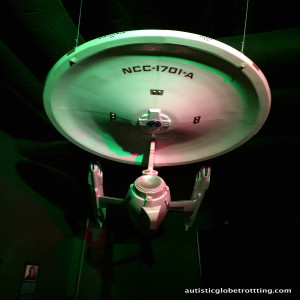Episodes

Thursday Aug 27, 2020
Thursday Aug 27, 2020
Veterinarian Dr. Jules Benson does not compete crazily at cycling, but he loves all the other aspects of it: the choice of how and where to ride each day he goes out, the acquisition and enjoyment of a new bike with a new frame (hopefully lighter?), the touch of masochism that comes with pushing yourself hard physically.
He tells himself, like all the other less-than-perfect cyclists, that speed doesn’t matter, but, y’know, it always does. Because isn't that some of the fun of bicycles, whether you’re cruising down a road to the beach, hoofing it to work, careening and bumping down a mountain trail, or staying off pavement and on gravel to avoid cars? Zoom zoom.
Jules sees biking as so multifaceted, “it’s anything you want,” he says.
Early on, I drag Jules into talking about the details of tire choices (he’s not kidding about the deep discussions on tire width and air pressure), but then he properly drags me back to talk about more interesting ideas behind cycling: the why, the how and the who of it.
He talks a few times about the “clannish” world of cyclists, like other hobby communities (I know the music world’s well), that talk about insiders and outsiders.
“I can live without that,” Jules confesses. “I’ve never felt the need to have sharp elbows [in competition]. I’d rather be a collaborator and be someone who is part of something bigger.”
Of course, we talk about the pandemic, because Jules explains, with bike shops closed for months, “he’s had to work out a lot of things himself” when it comes to maintaining and changing things on his bike. (Now he’s back to his local bike shop, and he encourages you to visit yours.)
Jules sounds a balanced view of his hobby, and I learned a lot from it. You will too. Dig into the kinds of fans in hobbies and how Jules uses the bike as a tool not a torture device (“not flagellation, but how hard can I go and how much can I push myself,” he says) as well as how cyclists navigate the dangerous world of city commuting. This and more. You might be inspired to get back on that bike for some fresh air, pump your legs, and lean into the wind: "The cadence of turning the pedals and knowing that’s all you have to do,” Jules explains. “That’s a nice place to be.”
WANT TO KNOW MORE?
> After the podcast, Jules shared these websites and cycling personalities for reference and further learning:
>>> Benson name-drops Selene Yeager in the podcast. He also mentions efforts like this by the cycling community to get more women in on the fun of the sport.
>>> “Marrianne Vos is the most dominant living cyclist on the planet in terms of medals and palmarès (cycling lingo for a cyclist’s achievements and wins).” Also, talking about diversity in cycling, Jules name-drops an organization for another issue of diversity in veterinary medicine, Pride VMC (Veterinary Medical Community).
>>> "Phil Gaimon is a retired professional spreading the good word on cycling and being kind to each other,” Jules says.
>>> Nerd it out with this glossary.
Here are my notes:
>>> Jules’ No. 1 tip in dipping into cycling for the first time? Make sure your bike, however cheap or expensive it is, has been put together properly by a professional: brakes in the right spot, things tightened properly, etc. He’s even seen the fork the wrong way around.
>>> British immigrant Jules tells us it’s pronounced “al-you-MIN-ee-yum,” like it’s spelled “aluminium.” It is, in the Queen’s English. In America, we jettison the second “i.” Huh. Who’s weird? You decide. I like both pronunciations, and I like people always arguing about it.
>>> Benson drops a quote: “Riding a bicycle is the closest you can get to flying.” That was attributed to Robin Williams in a Wall Street Journal story (gated content). Williams loved cycling ...
>>> Types of fun, Jules tell us? Yeah. Jules says 1, 2a, 2b and 3. This one breaks it down as 1, 1.5, 2 and 3. Tuh-may-to, tuh-mah-to.
>>> Jules lays out some of the lingo and familiar names from the online cycling community: A nuanced view of “Freds” and “Dorises.” Congratulate another cyclist with “chapeau,” from cycling’s French influence. Rollers and punchers. Weight weenies and MAMILs. 853 steel, Spirit for Lugs, aluminium (!) Cannondale and big bike maker Tom Ritchey.
>>> Dost thou dare to explore the secret workings of the Velominati? (Jules says this started as a joke poking self-referential fun at cyclists, but the rule-makers eventually took the rules a little more seriously.) Hate it and want to see push-back? Bam.
>>> Jules has stopped to talk to car drivers who’ve unsafely (and illegally) passed him too close on the road. He name-drops the humorous look at this, Portlandia’s "Bicycle rights!”-yelling character, Spyke (first on the list of clips at Thrillist.com).
>>> Curious about Race Across America, which Jules’ friend did and needed a year to recover from? Well, the hyperlink already came earlier in this. It’s right. The name of the thing. Just … just click on it.

Tuesday Aug 18, 2020
Tuesday Aug 18, 2020
Gina Spadafori lives within what feels like spitting distance from California’s capitol city, Sacramento, but it’s also really rural right around here. It’s kind of the perfect spot for a politics-following writer and editor who decided to raise animals in her yard.
But this yearning for living close to animals and on a stretch of land didn’t come from her happily urban and suburban family.
“My maternal grandmother used to tell me, the best day of her life after World War II was when they were able to get anything they wanted at the supermarket,” Gina says, “and she didn’t have to have a victory garden, she didn’t have to can, she didn’t have to have chickens, and that was … the happiest day of her life.”
It started with horses and goats. But the horses were tough work on a solo micro-ranch. (“The first winter I was here, the entire pasture was under a good 10 inches of water,” she says.) Most recent head count? Seven goats, including two kids; nine chickens; one barn cat; and four dogs, who are the family members of her farm.
Find out the philosophy behind her relationship with the food animals she raises (“The chickens don’t have names,” she says, if she’s eating them), how micro farm vlogging transitioned from social media fun to just getting things done on the property, and what joys all this work brings.
P.S. I blow it at the very end and call Gina a “micro-farmer.” Gina sees that as a business farming, where farmers sell at least some of that produce. Makes sense. Gina’s got more, y’know, a ranch.
WANT TO KNOW MORE?
> Check out this video of the Pasadena, California, urban homestead that inspired Gina. (Check ‘em out on Facebook.)
> Interested in small farming vs. big farming? Gina’s not a fan of big-ag's poop lagoons. See a Vice story on them here. She also questions mono crops and massive fertilizer use. Better is the work of Joel Salatin, the sustainable agriculture in Gina’s own county and Sacramento’s own farm-to-fork rep.
> Gina travels in the veterinary medicine world, and her friend, Dr. Patty Khuly, was on the chicken and goat kick before her. Dr. Khuly warned Gina that her first backyard animals, chickens, were a “gateway livestock.” And it proved true. Dr. Khuly talks up goats here.
> Intrigued by the mention of Bernadette the Weather Duck? You’re welcome.

Thursday Jul 16, 2020
Thursday Jul 16, 2020
“I always loved comedy,” Tekurah says, since high school. Jake Johannsen was her first standup crush in the Bay Area.
“When somebody makes me laugh, I become attracted to them,” she says. She and her friends would crowd into a car on a day off school to stand around the studio for a drive-time radio show with lots of standup comedy guests. Funny, yes, but intoxicating and attention-holding in a way that comedy albums and TV appearances and sitcoms don’t quite compare: “Live comedy is my thing,” she says. “As an introvert, I save up all my energy, go to the club, then go home.”
That’s my superficial take of a deep discussion we have about humor here. You’ll dig it.
Find out why she can’t watch Crazy Ex-Girlfriend (“my secret shame,” she says), why she sits in the front row, and why her podcast has “paw” in the title but isn’t about animals (I had to drop that last one in to promote her kick-ass work).
WANT TO KNOW MORE?
> Tekurah lived through one comedy boom of the 1980s. Boom. It came back, kids. Will it come back again after COVID-19? Dunno. Here’s how it hit hard in the UK.
> Comics with troubling opinions, jokes and history? She had no trouble saying bye to following the work of comedian Louis C.K. after this. She tried Joe Rogan at a club (Bill Burr, whom Tekurah digs, talks to him here about COVID-19), but that didn’t work out. I couldn’t find Todd Glass’ politically incorrect joke (which, maybe, he doesn’t even perform anymore), so we’ll leave that out.
> The Comedy Store, which Tekurah found, is in West Hollywood. She's right: A comic died by suicide next door during a strike.
> Tekurah was weaned on public TV’s Comedy Tonight, hosted by Alex Bennett, who chats up Robin Williams and others on drive-time radio in San Francisco here
> Patton Oswalt and Blaine Capatch did crazy stuff on Comedy Central (case in point, with the voice of Penn Jillette)
> Rooster T. Feathers is where Tekurah saw Carlos Alazraqui (“one of the first comedians I saw live,” she says, and who did cartoons and played Garcia on Reno 911)
> Tekurah digs Jimmy Pardo (“The man who saved me from listening to Adam Carolla,” she says, and his fans’ “misogynist” ideas about what women have to offer men, and vice versa). She also digs Maria Bamford, with a joke about religion that’s “so perfect.”

Monday Jul 06, 2020
Monday Jul 06, 2020
Note: Our audio is clippy as all get-out. Don't hate us. Or, rather, hate me. Jahmal is getting better at this, and I brought his quality down. Take me. Take me as tribute. I cut so much good stuff outta here. I’m a damn shame. Y’know why? Because I did a podcast of someone else’s a couple week ago, and my audio was too loud, and I bet she went back in time to change the sound levels on this. That’s definitely more likely than I just didn’t pay any attention when I recorded it.
I talked to a guy online who said he knew some people. I showed up at a guy’s apartment, and there were a bunch of guys there. One of those guys, if I remember correctly, was Jahmal. Now I don’t even talk to that first guy online anymore, but Jahmal, well, I still talk to him.
Jahmal is one of the best role-playing game DMs, game masters, judges, referees, storytellers, whatever, around. He has a unique, damn near patent-pending (or should be) way of letting each game session evolve with the interests, problems, goals, pains and pleasures of the players who show up to pretend to be other people and roll some dice (usually) to decide conflicts.
There’s a special high the right game with the right people can deliver, he says, as stories go directions and characters take actions and players think up things no one thought possible: “There are moments in games where folks are doing their thing … and this synergy happens, I hate that word, but this synergy happens, and we’re all in this new space, and we’re all there … and the light bulbs come on for everybody. And no one saw it comin' sittin' down that night.
“My high is only capped by the table’s high.”
In this one, we explore what role-playing games are, why rules in games are important, and the difference between drama and shenanigans. It gets deep into the details, but stick around …
WANT TO KNOW MORE?
> You need Jahmal’s Patreon page like a flower needs water. He shares play sessions with his son and others, has in-depth discussions with other game makers, and he shares his thoughts regularly on games and things that touch on them. Check out his Transformers post.
> Want to find a friendly game store in your neighborhood? Try this website.
> What’s a dice pool? Roll dem bones!
> There are a lot of games out there. Here are a few mentioned:
>>> Apocalypse World (“Rated ‘R,’” says Jahmal, for adults) and other games “Powered by the Apocalypse,” such as Urban Shadows, Monster of the Week and Monster Hearts
>>> Ars Magica
>>> Burning Wheel, which Jahmal loooooves
>>> Dungeons & Dragons
>>> Gamma World
>>> Mutant Year Zero
>>> Pathfinder
>>> Star Wars

Monday Jun 22, 2020
Monday Jun 22, 2020
Dr. Ernie Ward is big on nutrition and exercise, but his love for surfing, paddle boarding and other sports in and around the ocean turns out to be bigger than that. He and his wife (his girlfriend at the time) bonded over a love of the ocean with SCUBA diving. And it’s his way of getting closer to nature.
“It's that connection with the energy … nature … this body that engulfs the entire planet,” Ernie says of the ocean. It’s a personal challenge, with risks, and a chance to interact with a water world full of fish, sharks and more. “I know that when I talk like that, people start to go, ‘Oh, Ernie’s getting into his woo-woo stuff.’"
Don’t tune out the “woo-woo”! Give it a chance. Ernie pitches us on how time on the water centers him and enriches his marriage (“We began our relationship in the water”), his family (“We raised our daughters surfing”), his mental state and his physical health (It’s an alternative to his Ironman work, which can be harder on the legs). And how he almost died in hurricane surf (roughly around minute 19).
(PHOTO CREDIT: "Raglan" by tkw954 is licensed under CC BY-NC-ND 2.0)
WANT TO KNOW MORE?
> Ernie surfs, but he also paddle surfs and paddle boards. Check him out paddle boarding with his dog and surfing.
> Ernie’s wife, Laura, was always a little turned off by surfing: too much jockeying for position, too out of the norm for a thirtysomething woman to surf with all those testosterone-riddled teens. Now, she’s into it, especially after a surfing trip she and Ernie took right before the COVID-19 pandemic hit. The L.A. Times write about gender in surfing here.
> Calcific tendinosis of the Achilles? “It just means my Achilles has turned into a solid mound of hard flesh, and it’s a real problem,” he says. Ouch.
> Ernie mentions a book from his friend, Steven Kotler, Stealing Fire; it’s on my reading list now. (Ernie clearly had Hunger Games on the brain, and he calls it Catching Fire.) Check out Kotler's website.

Monday Jun 15, 2020
Monday Jun 15, 2020
It started with ideas. Dr. Melissa Detweiler, a small animal veterinarian in a Midwestern small town, had a lot of them, and writing blogs, commentary and opinion seemed like the route. But she didn't know, as a veterinarian, which audience to tackle first: pet owners or those "in the profession," vet med.
"I wanted to say the things [in my blogs] to pet parents that maybe I held back from saying in the exam room," she says. Then she started writing pieces for veterinary magazines to her peers.
Her podcasting took a similar route, with her first podcast ("This Vet's Voice") aimed at veterinary clients, but her next aimed squarely at the emotional challenges of life for veterinary professionals ("DVM Divas").
Originally, it seemed a far-off idea. Audio snippets, sure, but a podcast? "Who can do that? That's not something little ol' me can do with my iPhone and earbuds," she says. "I used the voice memo app on my phone [for my first audio]."
And she says she was terrified at the outset, using a podcast alter ego name. Pet owners can get pretty bent out of shape online about things involving their pets. "[The alter ego] was my security blanket," Melissa says. "I can kind of hide under this umbrella here. It felt like it freed me up a little bit."
Now, well, she's out there, with two partners-in-crime (although it's not about crime, people) on her latest podcast.
Find out how she got more comfortable with her voice on audio, how she and her podcasting partners manage the conversation and what small-town America thinks of it.
(PHOTO CREDIT "File:Veterinary Office with dog.JPG" by MarkBuckawicki is licensed under CC0 1.0)
WANT TO KNOW MORE?
> Voiceover work is getting heavily advertised these days in work-for-home pandemic times. Melissa says she took an online course from Carrie Olsen, and she found it helpful in her podcasting.

Friday Jun 05, 2020
Friday Jun 05, 2020
Veterinarian and veterinary faculty member Dr. Ryane Englar still considers herself a “baby dancer,” although her teacher and dance partner, Lowell, saw her potential and gently encouraged her over their years of practice to dive into competition with him.
We start off the podcast with a fascinating consideration of how two dancers work together, one leading and one following, to maintain strict posture, movement, speed and flow by staying close together.
“If I start to slip, my pro partner can turn me so it looks pretty to the audience, but we both know he’s doing it to get me back where I need to be,” Ryane says.
Her descriptions of interaction between professional dancers and amateurs, men and women, leading, following and back-leading is fascinating. The art feels very gendered, with men leading and women following, and that just seems like an element of the art as performed today. However, Ryane says same-sex couples are “starting to make an appearance” in competitions and are actually common with certain dances in Europe.
The best part is hearing how dance added some tools to Ryane’s toolkit in her personal and professional life and gave her something that wasn’t about her veterinary work, “more than a definition,” she says.
Find out how Ryane got started dancing as an adult (ballet as a child didn’t do it: “I thought forever I would never dance beautifully,” she says), how Lowell helped her learn how to fall, and how it brings confidence in life and in dancing.
As Ray Davies sings, “Come dancing … ”
(Image by Peter H from Pixabay)
WANT TO KNOW MORE?
> Ryane drops a lot of names of different dance styles, and she covers it a little bit from “the student perspective.” But if you want to dig in at wikidancesport.com: American rhythm, American smooth, International ballroom, International Latin.
> Arthur Murray Dance Centers are Ryane’s choice. Find one around you?
>
Friday May 22, 2020
Friday May 22, 2020
Journalists want to help. Journalists want to get to the truth. Journalists don’t want to make mistakes. Mix in all three of those, and you’ve got a recipe for well-intentioned, purposeful perfectionism of a sort.
“I don’t think you have to be a journalist because you’re a worrier,” Portia says, “but I think it’s a driver.”
It’s the hunt for the second set of eyes on a piece, the second look, the critic’s skepticism. Portia gives that to team members, and she needs it from others. So, ultimately, part of the easing of anxiety comes from building in trust and collaboration with a team of people who’ve got your back.
Another big part of managing anxiety for Portia was discovering the power of the negative stories she would tell herself. Why think you’ve failed before you’ve found out?
“At the end, when it’s finished, and you’ve published something and moved on, and you don’t have feedback [yet],” Portia says, “why assume it’s broken or wrong when you could make a choice to say, ‘That was a success’?”
Find out how she manages giving and negative feedback, how she makes time to unwind, and what elementary-school kids called Portia (for only a bit).
(PHOTO CREDIT: Image by rawpixel.com)
WANT TO KNOW MORE?
> Do you struggle with anxiety? Take a quiz.
> Do you struggle with negative self-talk? Start tackling that.
> OOOooooh. That’s what a carboy is.
> Portia mentions leadership training. I got mine from Sunroad Coaching founder Marnette Falley in a previous life. So did Portia.

Saturday May 16, 2020
Saturday May 16, 2020
Star Trek debuted on CBS in 1966, the brainchild of creator Gene Roddenberry. Mindy, though, caught it first in afternoon reruns after she’d get home from school. She thinks that original series is good, but she really thinks everyone should be a Star Trek: The Next Generation Trekkie.
“Roddenberry gave us hope for the future,” she says. The new direction in the latest two shows, she feels, is more about “me” and less about “us,” losing some part of the original’s optimism and group solidarity.
The other big theme that pops up for Mindy in the shows is what makes us human and what we owe to the artificial beings we create. She says such Star Trek characters as the android Data and the hologram “The Doctor” spark the same sense of empathy she feels for pets. She hates seeing them abused and mistreated in films and TV shows.
“We brought the pet into our world, so anything that happens to them is our fault,” Mindy explains, and that’s “graduated” to thinking about other beings we might create in the future. It's the most philosophical and moral discussion we’ve gotten into on this podcast!
P.S. Mindy finally caught a bit of those new “Star Trek” shows. She says she liked them more than she thought she would.
P.P.S. I use one expletive. Don’t judge.
(PHOTO CREDIT: "Star Trek Exhibit Mall of America" by Margalit Francus is licensed under CC BY-NC-SA 2.0)
WANT TO KNOW MORE?
> Check out StarTrek.com.
> Humanists cover a little of Gene Roddenberry’s thinking from the show here. (Here’s a more pessimistic view on Roddenberry spun out of a book review of a two-volume history of the show.)
> Mindy gives an eloquent, heartbreaking description of a Star Trek: The Next Generation episode about a world that depends on the torment of a single being for its civilization’s success. Brendan was reminded of a dark tale of a place that relies on hurting a being for its own happiness. It’s “The Ones Who Walk Away From Omelas” by Ursula K. LeGuin. Brendan said it was 30 years ago; it’s closer to 50 years ago, first published in 1973.

Thursday May 07, 2020
Thursday May 07, 2020
I could have called her a midwife, but isn’t the word midwifery (pronounced MID-wiff-ree) cool?
Midwives act as emotional support, an educational resource and healthcare advocates for pregnant women. Roughly 97% of Cheryl’s mothers want a home birth. And 85% of them will have a home birth, with 15% going to a hospital instead. This is a hands-on relationship, with long, regularly scheduled appointments to check up with expectant mothers and their partners and listen to them and their concerns. It’s a close relationship, with many families coming back more than once for repeated home births.
“We’re coming to your environment, and we’re helping you to have your baby your way,” Gates says.
It’s a matter of preference. Other expectant mothers will only relax and feel safe in a bed at a top-notch hospital to give birth. Cheryl remembers, after a brain injury, how nice it was to get out of the hospital and into her own bed at home. She doesn’t dig hospitals.
The clients she can’t, in good conscience, take on? Those who say “no matter what” they won’t go to the hospital for a birth. That’s a dangerous choice, she says, as the health of mother and child before, during or after birth may necessitate a move to the hospital.
“You have to be willing to get help when you need it,” she says, “because that’s how it stays safe.”
Learn about what life is like for a midwife and for expectant mothers who don’t want to give birth in a hospital, what racism looks like in the hospital room, and how one generation’s bad childbirth experiences can haunt the next.
(Photo courtesy Pixabay; no, that's not a Cheryl-midwifed baby)
WANT TO KNOW MORE?
> Learn more about what midwives and nurse-midwives do as well as doulas.
> It was only one incident in many years of midwife work, but Cheryl mentions years ago that one healthcare provider had a sign on the wall that said expectant mothers who had a doula or had taken a Bradley class were not accepted as patients. The American College of Nurse-Midwives and the American College of Obstetricians and Gynecologists (what Cheryl calls “ACOG” in the podcast) play nice together now.
> Twilight sleep, knocking expectant mothers out during childbirth, many strapped to their beds, was totally a thing. Yuck.
> Cheryl mentions the 2008 documentary The Business of Being Born (The Business of Birth Control is up next from the filmmakers.) You can stream it free right now. Here are a few reviews here, here and here.

What People Do: Interviews of Discovery
When COVID happened, I started talking to friends, family and acquaintances about something they did. The topics, personalities, and conversational directions go many different ways, but the important thing remains the same: We are all worth the time it takes to sit down and talk a while to each other. What would you learn if you slowed down, asked more questions, and delved into something interesting to ... someone else?



